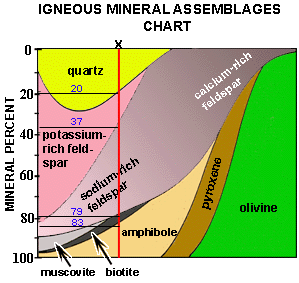 | "You may remember, Lou, from the 'lava flow' and 'magma chamber' rollovers, that igneous rocks are those that form through the cooling and crystallization of molten rock! And as we've seen, they can be made of minerals, glass, or a mixture of both! To make things simple, we will focus our attention on the minerals found in igneous rocks, since glass is less common!" |
|
 | "Good! I always appreciate simplicity!!" |
|
 | "You are getting to be one sophisticated guy, Lou! Anyway, after looking at thousands of terrestrial rocks (rocks formed on earth) that they are sure are igneous, geologists have created a simple chart that shows the minerals found in in any significant quantity in those rocks! The chart is designed to indicate not only which minerals occur in igneous rocks on earth, but also which minerals occur together in the same rock!" |
|
 | "I'd like to see that chart!!" |
|
 | "Here it is, Lou!" |
|
 | "I recognize the names of some of those minerals! There's quartz! And members of the mica and feldspar families! But I don't understand how the diagram shows the minerals that occur together in the same rock?!" |
|
 |
 | "Simple! The minerals that occur together lie along a vertical straight line! Take a rock such as 'X'. The percentages of minerals are shown by the lengths of the red line segments that lie within the colors representing the minerals! For example, from 0 to 20 on the 'mineral percent' axis, the red line lies within the quartz area; from 20% to 37% it lies within the potassium-rich feldspar area; and so on! All the minerals present in rock 'X' and their percentages are shown in the table below. Note the percents add up to 100!"
| Mineral | From | To | Length |
| quartz | 0% | 20% | 20% |
| potassium-rich feldspar | 20% | 37% | 17% |
| sodium-rich feldspar | 37% | 79% | 42% |
| biotite | 79% | 83% | 4% |
| amphibole | 83% | 100% | 17% |
| TOTAL = | 100% |
|
|
 |
 | "I get it! For example, rock 'Y' contains 20% calcium-rich feldspar, 18% pyroxene, and 62% olivine!"
| Mineral | From | To | Length |
| calcium-rich feldspar | 0% | 20% | 20% |
| pyroxene | 20% | 38% | 18% |
| olivine | 38% | 100% | 62% |
| TOTAL = | 100% |
|
|
 |
| "And notice Lou, that the minerals are particular about whom they associate with!" |  |
|
| "Yeh! I can see that quartz and potassium-rich feldpar kind of like each other, but quartz and olivine must be enemies! They wouldn't be caught together in the same rock!" |  |
|
| "You've got a sharp eye, Lou!! In fact, there's a special name for the minerals that occur together in a rock: a mineral assemblage! So you can see that for igneous rocks there are certain expected mineral assemblages!" |  |
|
 | "Language is so convenient! Thanks, Lulu!!" |
|
|
|
 | "So, in terms of using a rock's mineral composition as a clue to how it formed, can we conclude that if a rock's mineral assemblage matches one of the assemblages shown on the chart, then it must be igneous? That it formed through the solidification of a melt?" |
|
 | "Unfortunately, the answer is 'no'! There will have to be additional evidence, as we'll see when we investigate 'texture' and 'field relationships'!" |
|
 | "But what if we look at it in reverse?! Can we say that if a rock's mineral assemblage is not found on the chart, then it can't be igneous?!!"" |
|
 | "Sharp, Lou! Sharp! That's kind of right!" |
|
 | "Sharp is a compliment! I'll accept it! So here's a pointed question for you, Lulu! (Heh heh!) You tell me that the mineral assemblages on the chart are those found in igneous rocks and that if a rock doesn't have one of those assemblages, then it's not an igneous rock! But you also say that having one of those mineral assemblages is no guarantee that a rock is igneous!!
OK, so since having one of those mineral assemblages doesn't make a rock igneous, how do geologists know that they are looking at igneous rocks in the first place? And that the assemblages shown on the chart are igneous rock assemblages?!??"" |
|
 | "Since you're so smart Lou, I'm going to let you answer that one!!" |
|
|
 Why do you think geologists feel confident in saying that the rock assemblages shown on the chart are typical of igneous rocks? Why do you think geologists feel confident in saying that the rock assemblages shown on the chart are typical of igneous rocks?
|
To check your answers and get additional hints and information, click on the link. |



 Why do you think geologists feel confident in saying that the rock assemblages shown on the chart are typical of igneous rocks?
Why do you think geologists feel confident in saying that the rock assemblages shown on the chart are typical of igneous rocks?




 Why do you think geologists feel confident in saying that the rock assemblages shown on the chart are typical of igneous rocks?
Why do you think geologists feel confident in saying that the rock assemblages shown on the chart are typical of igneous rocks?
